Azalea on a trunk, what are the features of cultivation, rules of care
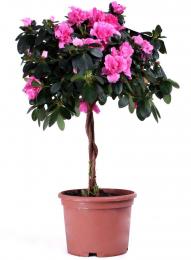
Azalea is an evergreen shrub with beautiful leaves, pubescent on both sides. The flowers are mostly single-colored - white, scarlet, purple, but there are also more interestingly colored varieties. There are both indoor and garden varieties.
Content:
- Types and varieties of azaleas
- Features of growing azaleas on a trunk
- Recommendations for choosing a plant
- Rules for caring for azaleas during flowering and at rest
- Azalea propagation
- What problems may arise during the growing process?
Types and varieties of azaleas
Azalea on a trunk is a perennial ornamental plant, indoor and garden type. Outwardly it resembles a tree, which is achieved through pruning. The article will tell you about the characteristics of different types and varieties of plants, care rules and possible difficulties.
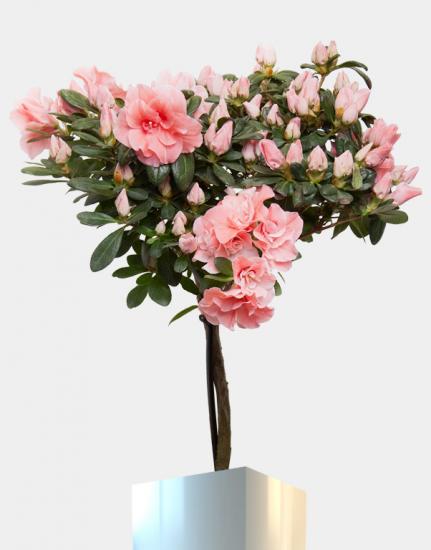
There are two main types found in home gardening.
Indian azalea (Rhododendron simsii)
Indoors it is small in size, ranging from 40-60 cm. In open soil it can reach 1.5 m or more. The species is characterized by heterogeneity of timing flowering, shapes, colors of different varieties. The flowers of this species are larger and are often variegated, double or smooth. A characteristic feature is the fact that yellow or orange coloring is rare among Simson's rhododendrons, and purple or blue coloring of the corollas is completely absent.
Japanese azalea (Rhododendron obfusum)
Indoors does not exceed 60 cm in height. Often, as it grows, it becomes shaped like a dense pillow. The size is relatively small, but this disadvantage is compensated by the abundance of flowering. Easily tolerates temperature fluctuations and pruning. This is why it is gaining popularity standard, pruned to resemble bonsai trees.
Modern breeders have developed many new varieties, but the most common are those listed below.
Azalea japonica Melina
It is distinguished by its bright carmine coloring and beautiful curved edges of the petals. It blooms profusely, the buds almost completely cover the leaves. It is distinguished by its small size - at the age of ten years it rarely exceeds 30 cm in height.
Japanese azalea Kermesina Alba
Snow-white buds are small in size, almost completely densely covering the branches;
Azalea “Knap Hill Sylphides” is a deciduous, frost-resistant variety. Can withstand temperatures down to -32C. The flowers are light pink at the corollas, with a bright yellow spot in the center. The shape resembles a funnel. Average height bush does not exceed 1.2 m.
Azalea Rhododendron Golden Lights
An unusually cold-resistant plant that can grow up to 150 cm. The buds are full, golden yellow, up to 7 cm in diameter.
Azalea hybrid Azurro
They are distinguished by large flowers of bright purple color with crimson dots on the inside of the corolla. The bushes grow up to 150 cm.
Hybrid azalea Rhododendron Golden Eagle
A cold-resistant deciduous plant that can reach a height of 1.8 m. The crown is wide, spherical in shape. The petals are semi-double, yellow and orange in color, reach 6 cm in diameter, collected in inflorescences of 6-12 pieces.
Deciduous Jolie Madame
One of the tallest bushes. At ten years it can grow up to 3 m. The flowers are simple and large. The color is pink, with a small orange spot in the center. One shoot can have 7-9 buds.
Deciduous Knap Hill Schneegold
In open ground it can grow up to 2 meters in height. The flowers are large, wavy along the edges, white with a yellow spot on the corolla and a pinkish tint along the edge.
Selection does not stand still and every year more and more different hybrids appear. Thanks to this, every gardener can choose a variety that will meet all aesthetic and biological requirements.
Features of growing azaleas on a trunk
Azalea on a trunk is distinguished by the presence of an axial trunk, which should be located perpendicular to the ground.
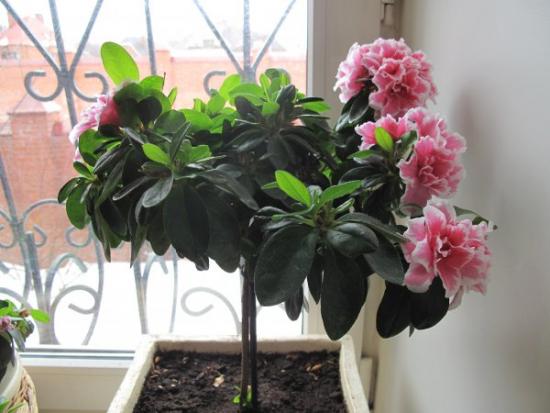
To form you need:
- Choose the strongest and strongest stalk;
- Cut off all side branches;
- Make sure that the cutting grows evenly; to do this, you can tie it to a bar and systematically turn the pot. Appearing side branches - cut off;
- When the trunk reaches the required height, pinch the top part so that the tree begins to branch.
If desired, after the trunk (trunk) is formed, you can experiment with the crown and give it the shape of a ball.
In addition to appearance care rhododendron, do not forget about other features:
- Lighting is an important factor in the life of rhododendron. A rather capricious plant does not tolerate direct sunlight. In summer it is better to place it in shaded areas. It is diffused light that is best received;
- Replanting - it is better to replant young ones every year, and more mature ones once every two to three years. Transplant it is better to use the transshipment method (transfer to a new substrate without clearing the soil from the roots). This will help keep the root system intact. It is recommended to use shallow pots as containers;
- Watering and humidity indicators - if the pot is placed indoors, it is recommended to maintain high humidity in the room. To do this, it must be watered and sprayed every morning. You can only use rainwater or water that has had time to settle. By autumn, the amount of watering and frequency of spraying should be reduced, but with the beginning of the heating season, increase again;
- Substrate – The ideal soil for this beauty is acidic soil. Grows well on hydroponics, heather soil, mixtures coniferous And peat soil;
- Temperature – the most suitable temperature for growing is considered to be 14-20C;
- Fertilizers. In spring and summer - potassium sulfate, ammonium, ammonia saltpeter. In winter and autumn - superphosphate at the rate of 15 g per 10 liters of water.
This is a rather willful representative of the fauna. Before you purchase it, it is recommended that you familiarize yourself with all the features of its cultivation, since if these standards are not followed, it may simply die.
Recommendations for choosing a plant
You can buy azalea on a standard at any flower shop. Both adult plants and seedlings are offered for sale. Prices for flowers with a height of 15 cm to 20 cm start from 500 rubles.
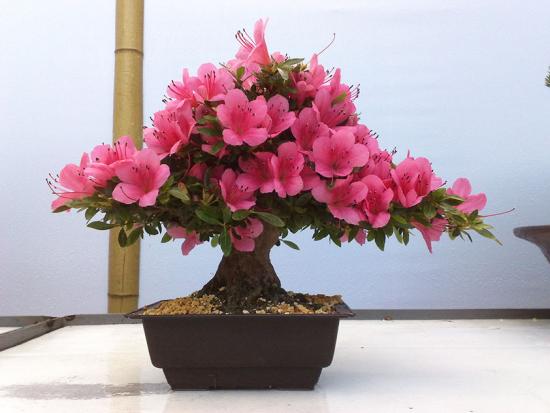
When purchasing, first of all, pay attention to:
- On the soil in the pot - it should be moist;
- The leaves should not fall off after a slight shaking;
- The color of the leaves should be uniform, and the plates should not be damaged;
- Size – it is better to choose medium.Big ones can have a hard time adapting to new conditions, while small ones simply cannot bear the change of environment.
After purchase it is recommended to replant rhododendron along with a lump of earth. A few days after transplanting, moisten the soil with a solution of Fundazol.
A whimsical, but incredibly beautiful plant, it is difficult to adapt to a change in environment, so when choosing, you should focus on strong, medium-sized flowers.
Rules for caring for azaleas during flowering and at rest
Caring for a standard azalea includes: pruning and pinching. Pruning It is better to start in late spring, removing weak and overgrown branches, especially those facing the room.
It is recommended to trim young branches, leaving no more than five leaves. If shoots appear at flower buds, they must be removed.
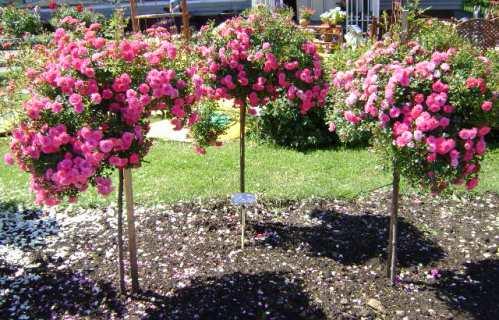
To prolong the flowering period of rhododendron, it is better to keep it in a cool room.
After the flowering period has passed, it is recommended to remove the seed pods. It is better to do this at all as flowering fades. If the boxes are not removed, the plant may weaken.
Belongs to the few representatives of the flora that are allowed to be transported. Thus, when an indoor azalea blooms, it is not only possible, but also recommended to be moved. But by the time of rest, it is better to return it to its place.
When the flowering period comes to an end, it is worth cutting off all the flowers so as not to exhaust the plant.
It is important to remember that even such a capricious beauty, with careful and proper care, will only bloom more magnificently every year. Thus, she will pay back a hundredfold for her care.
Azalea propagation
Can be done in several ways:
- Seeds – a difficult method, which is often used to improve new varieties;
- By dividing the bush - samples over three years old are suitable. To do this, you need to carefully divide it so as not to damage the root system and plant the resulting parts;
- Grafting - for this you must first take the plant on which the grafting will be carried out (rootstock). It is better if the rootstock is represented by cuttings measuring from 15 to 18 cm and belongs to an easily rooted variety. From the plant that will be grafted (scion), you need a cutting with a bud, which was taken during the period of pruning young branches. It is recommended to carry out grafting using the copulation method - make two identical sections on the scion and rootstock, lay them on top of each other and cover them with polyethylene on top. Place in a warm place, water abundantly until engraftment;
- Cuttings - the most common method of reproduction. To do this, it is recommended to take a half-woody cutting 6-8 cm long. This is best done from late spring to late summer. The cutting should be placed 2 cm in acidic soil (coniferous soil or sphagnum soil is suitable peat). The seedlings need to be covered with a glass container, watered systematically, maintaining the air temperature at 25C. Rooting takes three to five weeks.
Of all propagation methods, gardeners prefer cuttings. This method is one of the simplest and does not require special knowledge or skills.
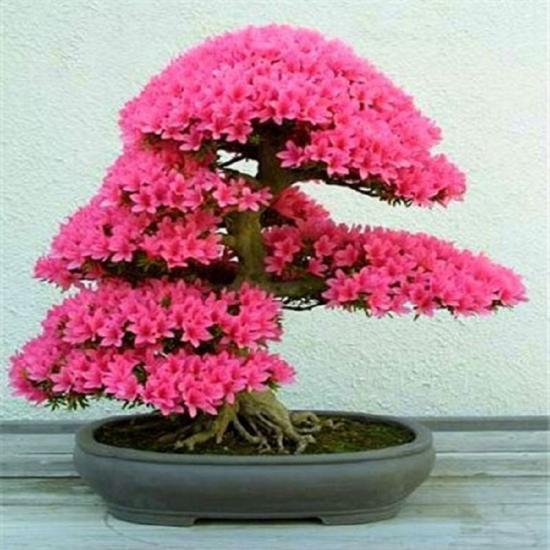
What problems may arise during the growing process?
A fastidious plant can bring many problems, but one of the main ones is pests. The main ones include:
- Furrowed weevil - enters the soil with water, in the form of larvae and eggs.During the day, insects hide, and at night they destroy the bark of stems and the edges of leaves. The larvae eat up the roots, causing the leaves to begin to dry out;
- Strawberry mite - affects the upper parts of plants. A characteristic feature of mite infestation is the folding of young leaves into a kind of boat, shredding occurs kidney, deformation of new leaves. The growth rate slows down, flowering stops;
- The greenhouse whitefly is a dangerous carrier of viral diseases. When they are damaged, the stem begins to lose color and the leaves wither. Sticky mucous discharge appears on the surface;
- Greenhouse thrips – reproduction occurs on the lower part of the leaf, where larvae develop and feed on adult insects. As a result of their vital activity, brown spots and black dots appear on the leaves - traces of excrement. The bud begins to turn yellow and lags behind in growth. Insects are most dangerous in the warm season;
- Slugs – appear on plants in the late evening or at night. They chew holes in leaves, destroy petals, and leave behind a distinctive silvery mucus;
- Aphid greenhouse - provokes leaf curling, inhibits growth and flowering;
- Citrus mealybug - attacks buds and flowers. Adults are located in the axils of buds, scales and cracks in the bark. When affected by scale insects, the leaves stop growing, they turn yellow and become covered with white cobwebs.
If the plant begins to wilt or marks appear on the leaves, it is recommended to take all necessary measures immediately. If pests are not neutralized in a timely manner, there is a danger of complete death. rhododendron and infecting neighbors in the garden.
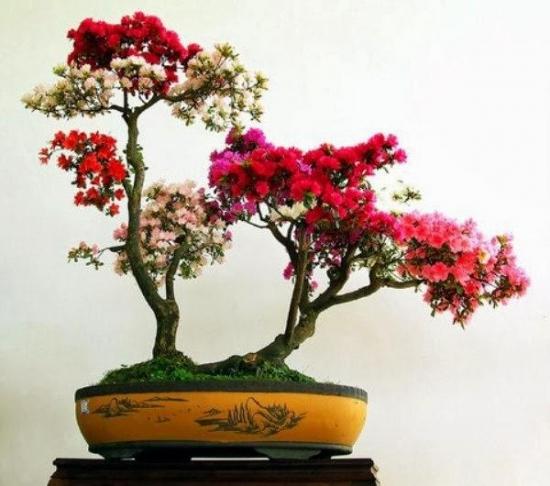
Azalea on a standard is a whimsical but incredibly beautiful plant that will decorate any flower garden. With proper care, it will delight the owner with abundant flowering for many years.
You can learn more about growing azaleas by watching the video:

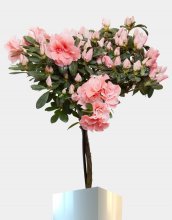
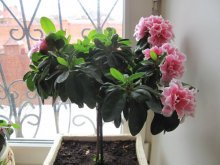
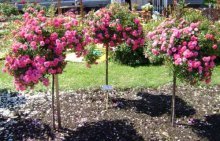
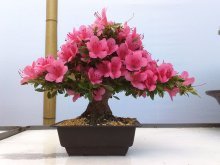
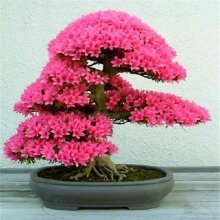
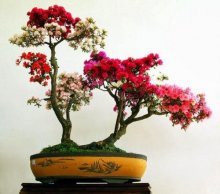
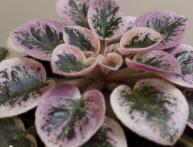
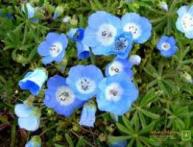
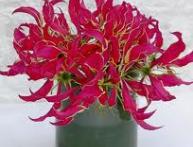
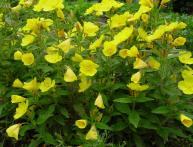

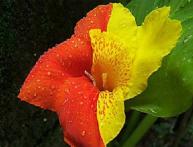
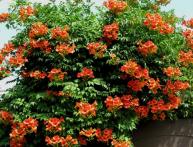
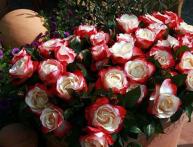
Comments
An incredibly beautiful mini-tree, a friend grows it and blooms with very bright flowers. When I first came to visit and saw it, I thought that Azalea was artificial. But as beautiful as she is, she is also harmful - a real woman.